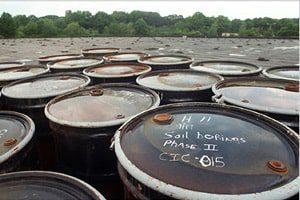
Love Canal, the notorious Niagara Falls, New York neighborhood that was the site of one of the worst toxic waste contaminations is the site of another round of illnesses. The Environmental Protection Agency (EPA) asserts that the neighborhood is safe. In the mid-1970s it was discovered that some 21,000 tons of toxic waste had been […]
 Love Canal, the notorious Niagara Falls, New York neighborhood that was the site of one of the worst toxic waste contaminations is the site of another round of illnesses. The Environmental Protection Agency (EPA) asserts that the neighborhood is safe.
Love Canal, the notorious Niagara Falls, New York neighborhood that was the site of one of the worst toxic waste contaminations is the site of another round of illnesses. The Environmental Protection Agency (EPA) asserts that the neighborhood is safe.
In the mid-1970s it was discovered that some 21,000 tons of toxic waste had been dumped in the area by then-Hooker Chemical (Occidental Petroleum Company today) as far back as 1942. Construction and heavy rainfall released chemical waste, leading to a public health emergency. Love Canal was added by the EPA to the Superfund National Priorities List on September 1, 1983 and encompassed a 70-acre site that consisted of the 16-acre hazardous waste landfill, a 40-acre cap, a drainage system, and a leachate collection and treatment system, according to the EPA.
Dumping stopped in 1952 and, in 1953, the landfill was covered and leased to the Niagara Falls Board of Education and later widely developed with homes and an elementary school. Complaints began in the 1960s and increased over the next decade as the water level rose, which brought contaminated water to the surface. Studies revealed a number of toxins in the surrounding area and waterways, according to the EPA. Nearly 1,000 families were evacuated and the site was responsible for what became the Federal Superfund legislation. The EPA declared that Love Canal was no longer a threat to human and environmental health, removing Love Canal from the Superfund National Priorities List in 2004. The area was repopulated, including 260 previously abandoned homes, the EPA noted.
According to The Buffalo News, in Love Canal—now Black Creek Village—residents are complaining of leaks, foul smells, and a number of adverse health reactions in people and their pets, including one family who alleges their baby’s birth defects are a result of toxins in the town. Also, three families have filed a $113 million state lawsuit over allegations that Love Canal is leaking and making people ill. According to The Buffalo News, another 300 families who are either existing or prior residents are either considering, or have joined, the lawsuit.
In a 20-page letter the families sent to the EPA in October 2011, they state that people and pets developed unexplained lumps, infections, and cancers and that white foam was seen on roads, sewers and drains; chemicals were seen in puddles; and high concentrations of toxic substances were in their homes. “We have reason to believe that Love Canal-era chemicals have migrated onto our yards and into our homes. We have suffered property damage and serious ongoing health problems,” according to The Buffalo News. “The matter is urgent,” they added. The EPA responded that it determined that the Love Canal containment system is operating “properly and effectively.”
The lawsuit alleges that Love Canal is responsible for the contamination while state and federal officials disagree saying the neighborhood is safe and that former Love Canal’s toxins are safely secured underground and monitored daily. “I wouldn’t have any problem living across the street from Love Canal,” Niagara Falls Mayor Paul A. Dyster, told The Buffalo News. Dyster does not live in Love Canal.
Meanwhile, in 2011 poisonous waste was found in a sewer outside the landfill. Workers dug a 50-foot trench and discovered sediment contaminated with toxins that were so potent a worker’s shoelaces disintegrated, according to The Buffalo News. One lawsuit asserts that the chemicals “can be directly linked” to Love Canal and that workers used hoses and attempted to flush the contaminate down sewers and storm drains instead of contacting an environmental cleanup crew, resulting in the workers “dispersing the contaminants even further onto and into the property and homes” of area residents.
Environmental activist Stephen U. Lester, the science director of the Center for Health, Environment & Justice who has done extensive research at Love Canal for more than three decades told The Buffalo News that the government never should have permitted the area to be settled and residents were never fully made aware of the dangers there.


